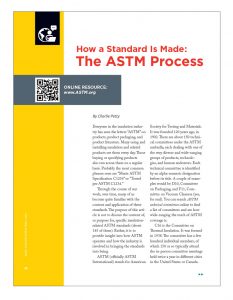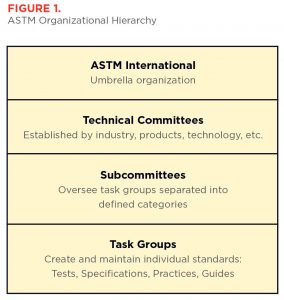How a Standard Is Made: The ASTM Process
Everyone in the insulation industry has seen the letters “ASTM” on products, product packaging, and product literature. Many using and installing insulation and related products see them every day. Those buying or specifying products also run across them on a regular basis. Probably the most common phrases seen are “Meets ASTM Specification C1234” or “Tested per ASTM C1234.”
Through the course of our work, over time, many of us become quite familiar with the content and application of these standards. The purpose of this article is not to discuss the content of, or purpose for, specific insulation-related ASTM standards (about 145 of them). Rather, it is to provide insight into how ASTM operates and how the industry is involved in bringing the standards into being.
ASTM (officially ASTM International) stands for American Society for Testing and Materials. It was founded 120 years ago, in 1902. There are about 150 technical committees under the ASTM umbrella, each dealing with one of the very diverse and wide-ranging groups of products, technologies, and human endeavors. Each technical committee is identified by an alpha-numeric designation before its title. A couple of examples would be D10, Committee on Packaging, and F11, Committee on Vacuum Cleaners (yes, for real). You can search ASTM technical committees online to find a list of committees and see how wide-ranging the reach of ASTM coverage is.
C16 is the Committee on Thermal Insulation. It was formed in 1938. The committee has a few hundred individual members, of which 150 or so typically attend the in-person committee meetings held twice a year in different cities in the United States or Canada. (The last few, of course, have been virtual.) The goal of the committee relative to industry representation is to achieve an appropriate balance in participation amongst Producers, Users, Consumers, and General Interest members. It is the nature of the beast that participants can have self interests to serve in their participation and proposals, but checks are in place to ensure that individual manufacturers, for example, do not enjoy advantages in voting numbers over their competitors or users of their products.
Below the technical committee in the ASTM hierarchy are subcommittees, and they are broken out to cover various segments of the standards family. The subcommittees are set up to oversee the activities of task groups that create and maintain individual standards—there is one for every ASTM standard. These standards include Material Specifications, Test Methods, Practices, and Guides. The first two constitute the majority of standards we get involved with in the course of our work.
Figure 1 depicts the ASTM organizational hierarchy. It is best to start at the bottom and work up to understand the process of getting standards in place. All standards activities—creation of new standards or revisions to existing ones—start at the task group level. Depending on the level of interest in, and extent of use of, a particular standard, participation in a task group meeting may range from a couple of members to a couple of dozen. Through the voting process, however, all technical committee members ultimately are able to see what actions (revisions, new standards) are being taken.
In the creation of a new standard, any member of the C16 technical committee may take a proposal to the task group. A new standard would be based on a need that the member sees in the industry. Relative to specifications, the need may be to cover a new product, or to cover product(s) that have been in use for years and simply never had a standardized document to cover them. When it comes to test methods, more often than not, a previously undocumented test method is embedded in a new specification, where it is described in a section within that specification. Per ASTM guidelines, that method must be converted into a stand-alone standard at the earliest opportunity. Practices and guides originate when there is a recognized need to bring standardization to how things are done in the use or selection of insulation-related products, to aid in the use of test methods, as support for design or engineering tasks, and for various other purposes.
As to revisions of existing standards, any member of the C16 committee may propose a revision to any standard, again starting at the task group level. The process of initiating and approving a revision is the same as for the creation of a new standard.
If there is general agreement among the task group participants that a proposed standard or revision is needed, one or more task group member(s) will create a draft document. Subsequent review and discussion among members will yield a final form; then a “ballot item” is created, consisting of the proposed new standard or revision and the rationale for it.
Is it important to note that ASTM is a consensus organization wherein eligible members vote on the ultimate approval of standards, whether they be new ones or revisions of existing standards. All proposed new standards and revisions are at some point presented to the entire committee membership to vote on for final approval. The document editing and voting process may end up being repeated one or more times, with changes made each time, until membership is satisfied with the final product and it is approved for publication.
Through this process, negative votes are resolved either by overriding (again, by vote) or by making changes to accommodate the voters’ suggestions. A voter has the opportunity to appeal his or her overridden negative at two or three levels. At the end of the day, all votes and input get fair consideration, but consensus rules; and, of course, one cannot expect 100% of the members to be happy 100% of the time.
Revisions can sometimes get approved in a matter of a few months, possibly agreed upon quickly at the task group level and then approved in the first ballot, but it could take a couple of years or more. New specifications normally take longer. In either case, getting details right and/or dealing with contentious points can cause the process to drag out many years.
Concerning C16 membership categories and the balances thereof, of the four mentioned earlier, Consumers and Users (of products) are generally not well represented. As it relates to NIA membership, while the major insulation and related product manufacturers are always active, there is virtually no participation at the distributor/fabricator, metal building insulation laminator, or contractor levels in task groups. This has been a concern for years. NIA members should be aware that the opportunity is there to be part of the process and make their needs known.
It can take a lot of time and work to get ASTM standards implemented or updated. Generally speaking, a relatively small number of members attend the meetings and do the grunt work, and their efforts should be applauded. Likewise, those NIA employers who support standardization and integrity in the industry by dedicating personnel resources to this purpose are due recognition.


